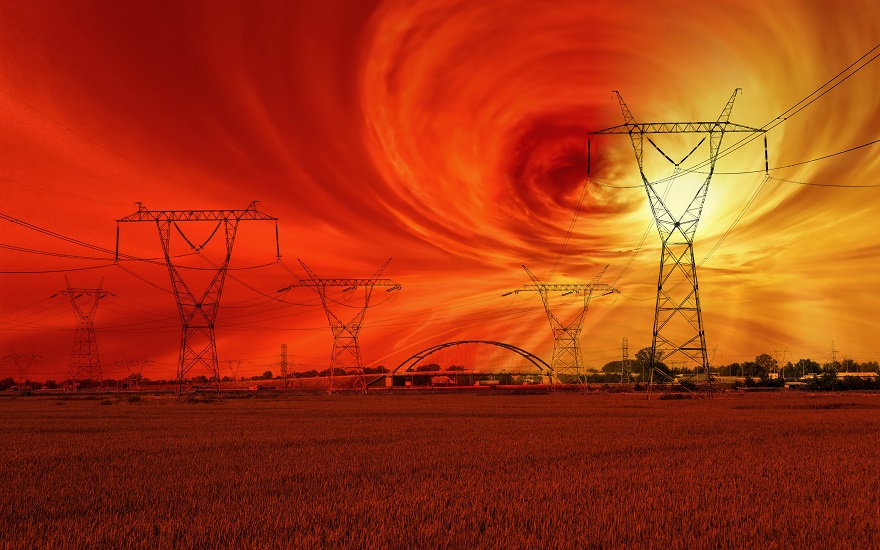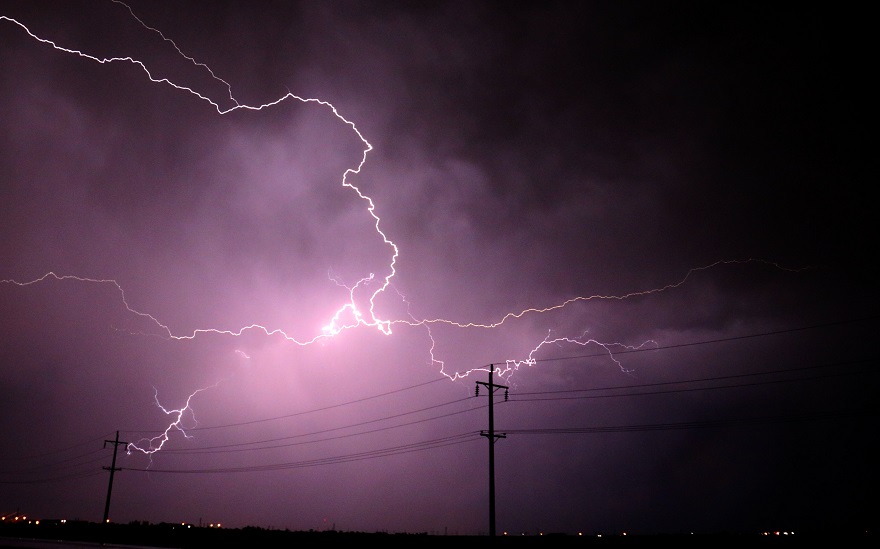Could a solar storm cause a catastrophic collapse of our power grid? We look back to the Carrington Event of 1859 to assess the likelihood.
In official government risk planning documents, space weather is one of the biggest threats that could cause the highest impact on UK infrastructure.
It carries a ‘Very High’ grade on the latest National Risk Register, with a warning a severe incident could cause “widespread disruption to the electricity network”.
But what is space weather and why does it pose such a hazard? We’ll answer those questions in this article.
And we’ll take a look back at the largest space weather event ever recorded and assess what damage it would cause if it happened again today.
What Is Space Weather?
Space weather covers everything related to the activity of the sun. The sun orbiting Earth goes through an 11-year cycle where its activity increases and decreases.
When the sun is at it’s most active, enormous magnetic whirlwinds erupt from its surface. Sometimes these flares shoot out from the sun’s surface. This sends a mass of highly-charged particles into space.
Solar storms heading towards Earth fall under three categories:
- Solar flares: high-energy sunlight comprised of x-rays and ultraviolet light. They can reach the Earth in minutes and interfere with radio communications
- Solar energetic particles: slower travelling and can produce a radiation storm. They are potentially dangerous to unprotected astronauts
- Coronal mass ejections (CME): a slower moving cloud of charged particles that builds up over several days before reaching the Earth’s atmosphere. The solar particles in a CME can clash with the Earth’s magnetic fields, producing powerful electromagnetic storms.
Small solar flares happen fairly often and have the potential to knock Global Positioning System (GPS) satellites out of action.
Larger magnetic storms can result in charged particles colliding with the Earth’s magnetic fields. This causes inadvertent power surges that have the potential to blow out giant transformers and trip out entire electricity networks.
We’ve known about the space weather phenomenon for hundreds of years. But our interest is keener today as we better understand the consequences of a serious solar storm affecting our power and communications networks.
Are there any lessons we can learn from more than 160 years ago and the biggest ever space weather event recorded on Earth?
What Is The Carrington Event?
When English astronomer Richard Carrington headed to his observatory just outside of London on the morning of 1 September 1859, little did he know he was about to witness history.
As he sat recording images of sunspots projected through his telescope onto a small screen, he saw something unusual.
Carrington described the scene for a report published in the Monthly Notices of the Royal Astronomical Society journal: “Two patches of intensely bright and white light broke out.
“My first impression was that by some chance a ray of light had penetrated a hole in the screen attached to the object-glass, by which the general image is thrown into shade, for the brilliancy was fully equal to that of direct sunlight.”
Five minutes later these blinding lights vanished. Within hours they were seen across the planet. An enormous solar flare travelling at more than 4 million miles per hour containing the energy of 10 billion atomic bombs…
That night, colourful auroras illuminated the skies. Sightings of the northern lights came from as far south as Cuba and Honolulu, while people in Santiago, Chile were able to view the southern lights.
It was claimed people could read the newspaper print purely from the powerful light from the solar flare.
But the Carrington Event wasn’t just an amazing light show, it had a far-reaching impact. Telegraph communications systems used to send private messages stopped working.
Sparks flew out of telegraph machines, giving electric shocks to operators and in some cases even bursting into flames.
When the telegraphs eventually came back online, chatter buzzed about what people had seen the night before.
Newspapers as far afield as France and Australia reported on the flares that had turned night into day in an instant.
What Would Happen If We Had Another Carrington Event Today?
Life was far simpler when the Carrington Event occurred in the mid-19th century. No major electrical networks. No telephone systems. Certainly no internet or satellites.
The Cabinet Office’s 2015 Space Weather Preparedness Strategy warns there’s a 1% annual probability of a reoccurrence of the Carrington Event. A CME on a similar scale missed the Earth’s orbit by approximately nine days back in July 2012.
But anything approaching the severity of the 1859 incident today would have far-reaching consequences for our 21st-century tech-dependent society.
It’d be powerful enough to knock out electrical and telecom systems throughout the world, with huge consequences for transportation, banking, and public services. The GPS satellites our phones, cars and aeroplanes rely on would be out of action too.
How long would the disruption last for? Day? Weeks? The worst-case scenario would see the chaos drag on for months or even years.
Disaster recovery specialists from America’s National Research Council reckon the damage would total up to $2 trillion in the first year following the event. At worst, they claim the damage bill would eventually add up to $20 trillion.
Would we know that a CME was coming? Space weather forecasters say that the biggest solar storms travel slow enough to be detected by satellites well before they strike the earth. Experts estimate we might have about 20 hours’ notice to take action.
This would give electricity system operators such as National Grid in the UK the chance to take valuable transformers offline ahead of any storm. In theory, this would limit the damage to more localised blackouts rather than taking the entire network out.
A solar storm doesn’t have to reach the seriousness of the Carrington Event to cause severe damage though.
A geomagnetic storm in March 1989 caused the collapse of Canada’s Hydro-Québec electricity network in just 90 seconds. Nine million people across the province left without power for up to nine hours.
On Valentine’s Day (14 February) 2011, the largest solar flare recorded in four years interfered with radio transmitters and radars on long-haul aeroplane flights.




